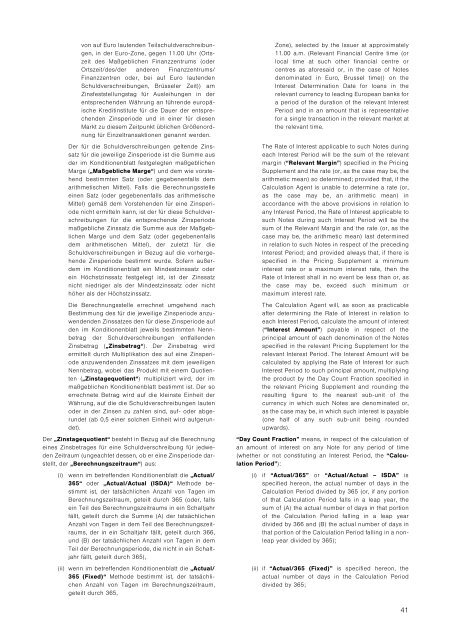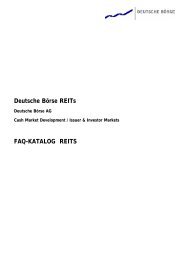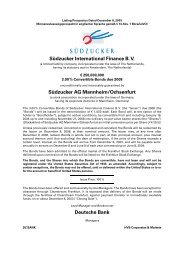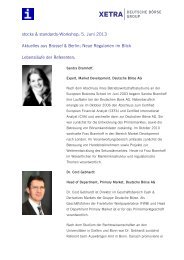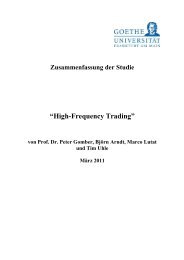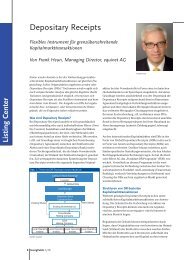Dresdner Bank Aktiengesellschaft Dresdner Finance B.V. - Xetra
Dresdner Bank Aktiengesellschaft Dresdner Finance B.V. - Xetra
Dresdner Bank Aktiengesellschaft Dresdner Finance B.V. - Xetra
You also want an ePaper? Increase the reach of your titles
YUMPU automatically turns print PDFs into web optimized ePapers that Google loves.
von auf Euro lautenden Teilschuldverschreibungen,<br />
in der Euro-Zone, gegen 11.00 Uhr (Ortszeit<br />
des Maßgeblichen Finanzzentrums (oder<br />
Ortszeit/des/der anderen Finanzzentrums/<br />
Finanzzentren oder, bei auf Euro lautenden<br />
Schuldverschreibungen, Brüsseler Zeit)) am<br />
Zinsfeststellungstag für Ausleihungen in der<br />
entsprechenden Währung an führende europäische<br />
Kreditinstitute für die Dauer der entsprechenden<br />
Zinsperiode und in einer für diesen<br />
Markt zu diesem Zeitpunkt üblichen Größenordnung<br />
für Einzeltransaktionen genannt werden.<br />
Der für die Schuldverschreibungen geltende Zinssatz<br />
für die jeweilige Zinsperiode ist die Summe aus<br />
der im Konditionenblatt festgelegten maßgeblichen<br />
Marge („Maßgebliche Marge“) und dem wie vorstehend<br />
bestimmten Satz (oder gegebenenfalls dem<br />
arithmetischen Mittel). Falls die Berechnungsstelle<br />
einen Satz (oder gegebenenfalls das arithmetische<br />
Mittel) gemäß dem Vorstehenden für eine Zinsperiode<br />
nicht ermitteln kann, ist der für diese Schuldverschreibungen<br />
für die entsprechende Zinsperiode<br />
maßgebliche Zinssatz die Summe aus der Maßgeblichen<br />
Marge und dem Satz (oder gegebenenfalls<br />
dem arithmetischen Mittel), der zuletzt für die<br />
Schuldverschreibungen in Bezug auf die vorhergehende<br />
Zinsperiode bestimmt wurde. Sofern außerdem<br />
im Konditionenblatt ein Mindestzinssatz oder<br />
ein Höchstzinssatz festgelegt ist, ist der Zinssatz<br />
nicht niedriger als der Mindestzinssatz oder nicht<br />
höher als der Höchstzinssatz.<br />
Die Berechnungsstelle errechnet umgehend nach<br />
Bestimmung des für die jeweilige Zinsperiode anzuwendenden<br />
Zinssatzes den für diese Zinsperiode auf<br />
den im Konditionenblatt jeweils bestimmten Nennbetrag<br />
der Schuldverschreibungen entfallenden<br />
Zinsbetrag („Zinsbetrag“). Der Zinsbetrag wird<br />
ermittelt durch Multiplikation des auf eine Zinsperiode<br />
anzuwendenden Zinssatzes mit dem jeweiligen<br />
Nennbetrag, wobei das Produkt mit einem Quotienten<br />
(„Zinstagequotient“) multipliziert wird, der im<br />
maßgeblichen Konditionenblatt bestimmt ist. Der so<br />
errechnete Betrag wird auf die kleinste Einheit der<br />
Währung, auf die die Schuldverschreibungen lauten<br />
oder in der Zinsen zu zahlen sind, auf- oder abgerundet<br />
(ab 0,5 einer solchen Einheit wird aufgerundet).<br />
Der „Zinstagequotient“ besteht in Bezug auf die Berechnung<br />
eines Zinsbetrages für eine Schuldverschreibung für jedweden<br />
Zeitraum (ungeachtet dessen, ob er eine Zinsperiode darstellt,<br />
der „Berechnungszeitraum“) aus:<br />
(i) wenn im betreffenden Konditionenblatt die „Actual/<br />
365“ oder „Actual/Actual (ISDA)“ Methode bestimmt<br />
ist, der tatsächlichen Anzahl von Tagen im<br />
Berechnungszeitraum, geteilt durch 365 (oder, falls<br />
ein Teil des Berechnungszeitraums in ein Schaltjahr<br />
fällt, geteilt durch die Summe (A) der tatsächlichen<br />
Anzahl von Tagen in dem Teil des Berechnungszeitraums,<br />
der in ein Schaltjahr fällt, geteilt durch 366,<br />
und (B) der tatsächlichen Anzahl von Tagen in dem<br />
Teil der Berechnungsperiode, die nicht in ein Schaltjahr<br />
fällt, geteilt durch 365),<br />
(ii) wenn im betreffenden Konditionenblatt die „Actual/<br />
365 (Fixed)“ Methode bestimmt ist, der tatsächlichen<br />
Anzahl von Tagen im Berechnungszeitraum,<br />
geteilt durch 365,<br />
Zone), selected by the Issuer at approximately<br />
11.00 a.m. (Relevant Financial Centre time (or<br />
local time at such other financial centre or<br />
centres as aforesaid or, in the case of Notes<br />
denominated in Euro, Brussel time)) on the<br />
Interest Determination Date for loans in the<br />
relevant currency to leading European banks for<br />
a period of the duration of the relevant Interest<br />
Period and in an amount that is representative<br />
for a single transaction in the relevant market at<br />
the relevant time.<br />
The Rate of Interest applicable to such Notes during<br />
each Interest Period will be the sum of the relevant<br />
margin (“Relevant Margin”) specified in the Pricing<br />
Supplement and the rate (or, as the case may be, the<br />
arithmetic mean) so determined; provided that, if the<br />
Calculation Agent is unable to determine a rate (or,<br />
as the case may be, an arithmetic mean) in<br />
accordance with the above provisions in relation to<br />
any Interest Period, the Rate of Interest applicable to<br />
such Notes during such Interest Period will be the<br />
sum of the Relevant Margin and the rate (or, as the<br />
case may be, the arithmetic mean) last determined<br />
in relation to such Notes in respect of the preceding<br />
Interest Period; and provided always that, if there is<br />
specified in the Pricing Supplement a minimum<br />
interest rate or a maximum interest rate, then the<br />
Rate of Interest shall in no event be less than or, as<br />
the case may be, exceed such minimum or<br />
maximum interest rate.<br />
The Calculation Agent will, as soon as practicable<br />
after determining the Rate of Interest in relation to<br />
each Interest Period, calculate the amount of interest<br />
(“Interest Amount”) payable in respect of the<br />
principal amount of each denomination of the Notes<br />
specified in the relevant Pricing Supplement for the<br />
relevant Interest Period. The Interest Amount will be<br />
calculated by applying the Rate of Interest for such<br />
Interest Period to such principal amount, multiplying<br />
the product by the Day Count Fraction specified in<br />
the relevant Pricing Supplement and rounding the<br />
resulting figure to the nearest sub-unit of the<br />
currency in which such Notes are denominated or,<br />
as the case may be, in which such interest is payable<br />
(one half of any such sub-unit being rounded<br />
upwards).<br />
“Day Count Fraction” means, in respect of the calculation of<br />
an amount of interest on any Note for any period of time<br />
(whether or not constituting an Interest Period, the “Calculation<br />
Period”):<br />
(i) if “Actual/365” or “Actual/Actual – ISDA” is<br />
specified hereon, the actual number of days in the<br />
Calculation Period divided by 365 (or, if any portion<br />
of that Calculation Period falls in a leap year, the<br />
sum of (A) the actual number of days in that portion<br />
of the Calculation Period falling in a leap year<br />
divided by 366 and (B) the actual number of days in<br />
that portion of the Calculation Period falling in a nonleap<br />
year divided by 365);<br />
(ii) if “Actual/365 (Fixed)” is specified hereon, the<br />
actual number of days in the Calculation Period<br />
divided by 365;<br />
41


